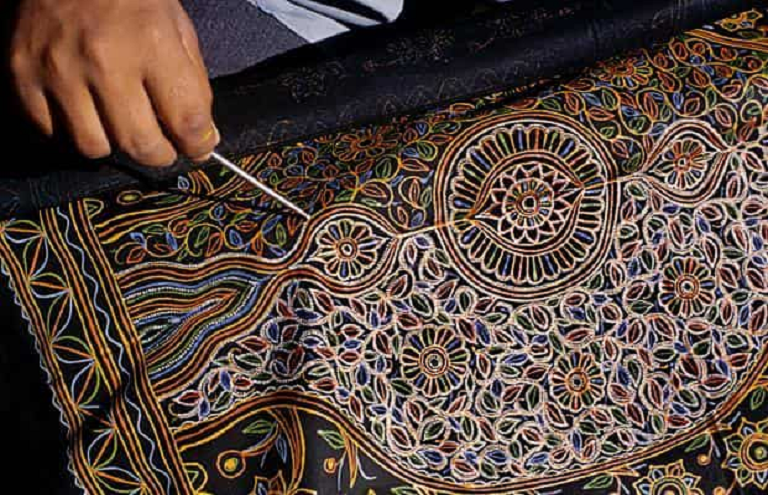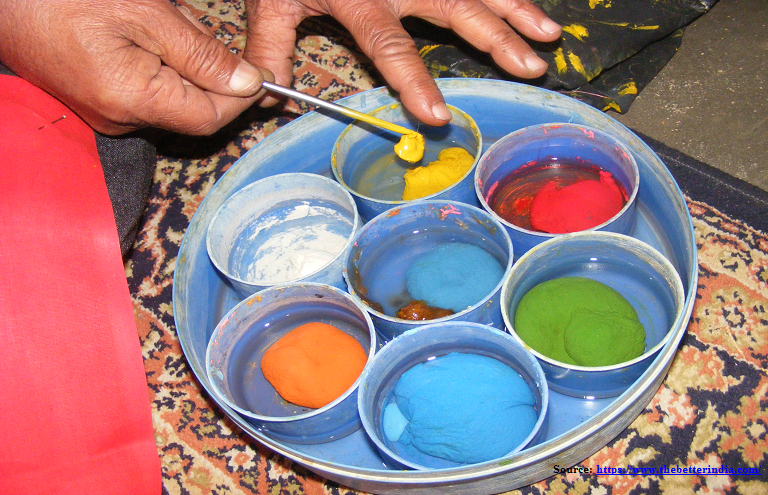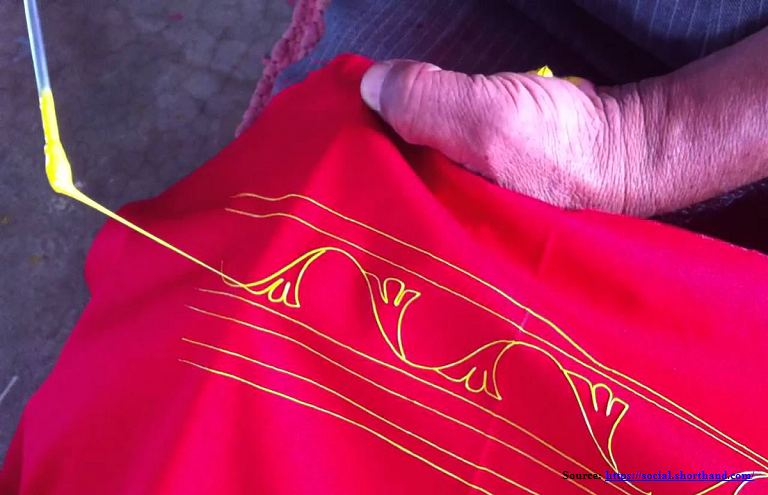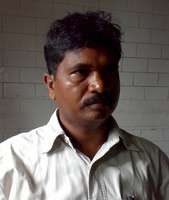
Being a cauldron of culture and religion, India is home to numerous traditional art forms. One such art form is the 300-year-old Rogan craft. It has traveled the world with our Prime Minister, Narendra Modi, who gifted to the then U.S. President, Barack Obama an intricately patterned ‘Tree of Life’ Rogan painting, during his visit to the White House in 2014. Embracing the walls of the white house, this mesmerizing Indian art is recognized all over the world and is a now pride of our country.
Meaning ‘oil-based’ in Persian, the paint of Rogan art is made from locally grown castor seed oil. Having its origin in Persia some 300 years ago, this art form was traditionally used to embellish bridal trousseaus of regional tribes. But as it crossed borders after borders, it slowly began fading from the collective memory of its creators. But, a lone Muslim family, the Khatris, in the remote village of Nirona in the Kutch district of Gujarat, is the last surviving custodians of this age-old art form.
The Making
Made without any tracing or drawing, Rogan art is 100% an artist’s own imagination on a piece of cloth, often requiring a lot of creativity and patience.
“The designs are not planned. They just flow from within us and that is why no one is able to replicate Rogan art.” — Sumer Gafur Khatri
Preparing the base from castor seed oil is a long and cumbersome process and usually takes two-three days. Firstly, the oil is heated in a special vessel and continuously stirred for more than 12 hours so it doesn’t burn. After two days, the residue is mixed with cold water, which gradually thickens into a sticky paste called rogan. Finally, natural colour pigments (made from stones or plants) as per the choice of the artist are added to the oil base creating a thick dye, which is later stored in earthen pots. It helps to keep the paint moist and malleable.

Artists sit on the floor, pinning the two ends of the cloth they plan to work on to either their bottoms or a table frame. Next, placing a small amount of thick gummy paint on their palms, they create elaborate patterns using oversized blunt needles or rods. Their other hand under the cloth helps the paint spread and shape the motifs — geometric flowers, peacocks, birds, tree of life, etc. primarily drawn from the history and culture of the Kutch region as well as nature.
As the designs are mostly created towards one edge of the fabric, once a particular pattern is completed the cloth is folded into half to create a flawless mirror image on the other side. Later on, intricate detailing is done to every outline made on the fabric. Involving detailed and intricate designs, it takes 10 days to over a month and sometimes a year to complete a single piece of exquisite Rogan work.

An extraordinary feature of this painting technique is that during the entire process of the paint being carefully twisted into motifs, the stylus never comes into contact with the cloth. Hence, it is performed by artists who are adept at lining the cloth with motifs.
After drying, the Rogan painted fabric is used to make quilt covers, sarees, decorative wall hangings, stoles, cushion covers, tablecloths, and other utility items such as sling and shopping bags, mobile covers and even file folders.
Read More: Meet the 'Khaleesi' of Indian Art - Amrita Sher-Gil
The Custodians
The Khatris have held steadfast to the ancient art form for over three centuries now, making the quiet hamlet of Nirona the only ground holding the Rogan art form.
Practicing it for eight generations, this family has been working hard to protect their 300-year-old legacy from vanishing into the folds of history. Abdul Gafur Khatri, head of the Khatri family, mastered this Indian art form at the tender age of 13 years. He ensures his entire family along with his sons, brothers, and relatives learns and practices it in its pristine form.
Gafur Bhai as he is popularly known has been instrumental in popularising and blending the folk art of Rogan to suit contemporary needs and demands. Helping retain its old glory, he won the State Award from the Government of Gujarat in 1988, and the National Award in 1997. Recently in 2019, he was also awarded the fourth highest civilian award, the Padma Shri by the Government of India. He is also the proud owner of a visitor’s book that is full of impressive testimonials from people across the world including Japan, the United States, Spain, and Australia.
“I must confess that this is a dream come true.” — Gafurbhai Khatri on winning Padma Shri, 2019.

His family members have also won numerous awards (18 state and even national awards) and recognition from all over the world. From Narendra Modi, Rahul Gandhi to Shashi Tharoor, and a number of legendary actors such as Amitabh Bachchan, Asha Parekh, Waheeda Rehman, Shabana Azmi, and many filmmakers have visited the village of Nirona to look at the stunning creations and meet the family. They greet everyone with warmth, display their work for buyers, and also explain the techniques they use.
In another effort to further popularise this ancient Indian art form, the family also conducts live demonstrations for every visitor at their doorstep. In a 30-minute demonstration, the artist patiently addresses the questions and explain the entire process of making a Rogan painting —from making the dye to precisely putting it on the fabric. On average, the family gets 150 visitors a day. However, the numbers shoot up to 250 or 300 during the Rann Utsav and the Kutch desert festival.
Earlier an exclusive preserved for the male members of the Khatri family, they have started teaching this rare art form to other crafts people, including women and young girls. They regularly conduct workshops and trained more than 200 women for free, employing a few of them to help with the detailing work on the fabrics. Gafurbhai is also actively engaged in the process of opening a school for teaching this rare Indian art to kids from different families.
Thanks to the efforts of the Khatris, their village is now a hub for many young researchers and fashion students wanting to document their lives and create fabrics drawing inspiration from their unique art. A show on the history of Rogan art was also featured by a popular television channel, National Geographic. Also, recently the art has found a digital market place too, with a number of Rogan paintings available for sale on various online art galleries.
Indeed, it has been a long journey for the Khatri family — from reviving the ancient art to generating public interest and recovering from the massive Bhuj earthquake setback. But today, their efforts have been rewarded well with the art form witnessing a huge resurgence of interest, it is grabbing eyeballs not only across the country but worldwide.
No Tough Competition
Unlike other forms of textile art such as Parsi embroidery, Ajrakh that are facing a lot of struggle due to cheaper factory-made products and use of machines, Rogan art faces no such competition but meeting the demand of the modern market has been quite challenging.
“You will not find Rogan art the way you find other arts in the markets. It’s not because we don’t want it to go out to the people, it’s because we have limited resources. We go to five or six exhibitions around the country in a year, and the rest of the time we are at home, working.” — Gafurbhai Khatri
With the new generation not willing to carry forward the legacy of painstaking Rogan art, there has been a severe shortage of human capital. Had they learned the art and traveled to different parts of the country teaching the techniques to others, it would have spread the richness and awareness about Rogan art. Another factor affecting this art form is product diversity required to cater to the demands of the urban population.
To help this ancient Indian art form reach more people across the country, the state government has started incentivizing practicing Rogan artists. Many NGOs and startups are also training artists to adapt to contemporary needs — encouraging them to experiment with new patterns, motifs, designs, and even colour combinations. This will help them create products that have a different appeal, are affordable, and have a wider reach thereby creating a market for them.
Also Read: 5 Tips to Ponder When you Buy Indian Art
Wrap Up
Owing to the continued relentless efforts of the Khatris of Kutch, the majestic art of Rogan did not fade and wither in the sands of time, but has been reaching great heights and getting the recognition it deserves.





















